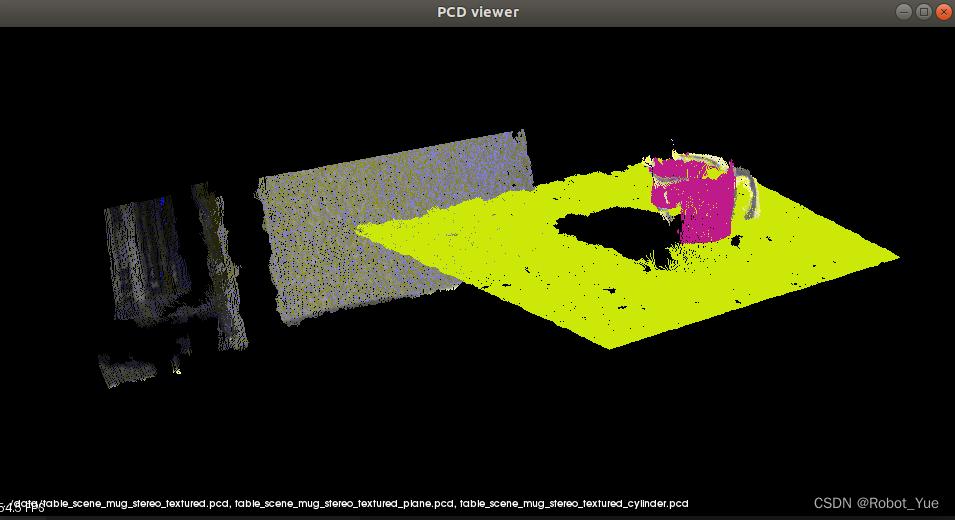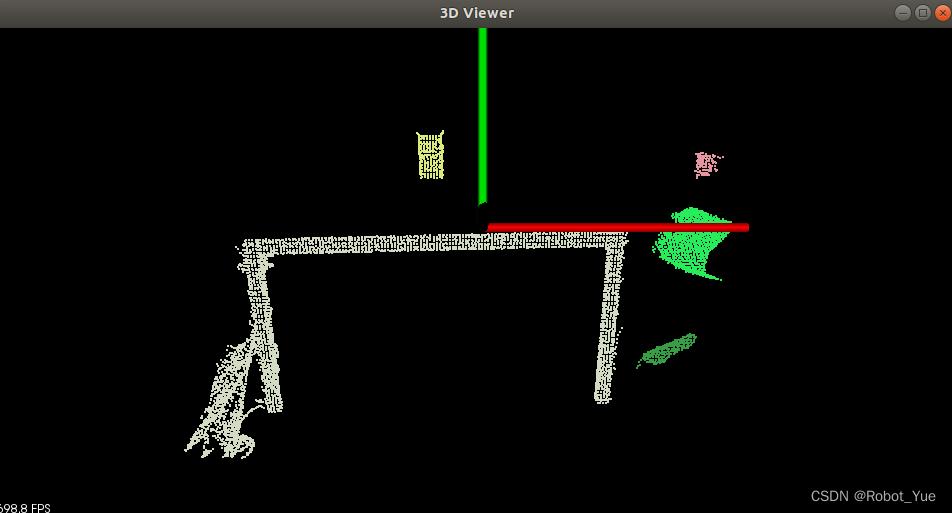参考引用
1. 引言
-
点云分割是根据空间、几何和纹理等特征对点云进行划分,使得同一划分区域内的点云拥有相似的特征。点云的有效分割往往是许多应用的前提,例如:在逆向工程 CAD/CAM 领域,对零件的不同扫描表面进行分割,然后才能更好地进行孔洞修复、曲面重建、特征描述和提取,进而进行基于 3D 内容的检索、组合重用等。在激光遥感领域,同样需要对地面、物体首先进行分类处理,然后才能进行后期地物的识别、重建
-
总之,分割采用分而治之的思想,在点云处理中和滤波一样属于重要的基础操作,在 PCL 中目前实现了进行分割的基础架构,为后期更多的扩展奠定了基础,现有实现的分割算法是鲁棒性比较好的 Cluster 聚类分割和 RANSAC 基于随机采样一致性的分割
-
PCL 分割库包含多种算法,这些算法用于将点云分割为不同簇。适合处理由多个隔离区域空间组成的点云。将点云分解成其组成部分,然后可以对其进行独立处理。下面这两个图说明了平面模型分割(上)和圆柱模型分割(下)的结果

2. 平面模型分割
-
planar_segmentation.cpp
#include#include #include #include #include #include #include int main(int argc, char *argv[]) { pcl::PointCloud<pcl::PointXYZ>::Ptr cloud(new pcl::PointCloud<pcl::PointXYZ>); // 生成 15 个无序点云,x,y 为随机数,z 为 1.0 cloud->width = 15; cloud->height = 1; cloud->points.resize(cloud->width * cloud->height); for (size_t i = 0; i < cloud->points.size(); ++i) { cloud->points[i].x = 1024 * rand() / (RAND_MAX + 1.0f); cloud->points[i].y = 1024 * rand() / (RAND_MAX + 1.0f); cloud->points[i].z = 1.0; } // 将 points 中 0、3、6 索引位置的 z 值进行修改,将之作为离群值 cloud->points[0].z = 2.0; cloud->points[3].z = -2.0; cloud->points[6].z = 4.0; std::cerr << "Point cloud data: " << cloud->points.size() << " points" << std::endl; for (std::size_t i = 0; i < cloud->points.size(); ++i) { std::cerr << " " << cloud->points[i].x << " " << cloud->points[i].y << " " << cloud->points[i].z << std::endl; } // 将输入的点云数据拟合成一个平面模型并返回该平面模型的系数 // coefficients 用于存储平面模型的系数;inliers 用于存储被拟合平面包含的点的索引 pcl::ModelCoefficients::Ptr coefficients(new pcl::ModelCoefficients); pcl::PointIndices::Ptr inliers(new pcl::PointIndices); pcl::SACSegmentation<pcl::PointXYZ> seg; seg.setOptimizeCoefficients(true); // 启用平面模型系数优化 seg.setModelType(pcl::SACMODEL_PLANE); // 设置模型类型为平面模型 seg.setMethodType(pcl::SAC_RANSAC); // 采用 RANSAC 算法进行估计,因为 RANSAC 比较简单 // 设置点到平面距离的阈值,用于确定属于平面的点集 // 只要点到 z=1 平面距离小于该阈值的点都作为内点看待,而大于该阁值的则看做离群点 seg.setDistanceThreshold(0.01); seg.setInputCloud(cloud); // 开始分割 // 将符合条件的点集索引存储在 inliers 中,平面模型系数存储在 coefficients 中 seg.segment(*inliers, *coefficients); if (inliers->indices.size() == 0) { PCL_ERROR("Could not estimate a planar model for the given dataset."); return (-1); } // 此段代码用来打印出估算的平面模型的参数(以 ax+by+ca+d=0 形式) // 详见 RANSAC 采样一致性算法的 SACMODEL_PLANE 平面模型 std::cerr << "Model coefficients: " << coefficients->values[0] << " " << coefficients->values[1] << " " << coefficients->values[2] << " " << coefficients->values[3] << std::endl; std::cerr << "Model inliers: " << inliers->indices.size() << std::endl; for (std::size_t i = 0; i < inliers->indices.size(); ++i) { std::cerr << inliers->indices[i] << " " << cloud->points[inliers->indices[i]].x << " " << cloud->points[inliers->indices[i]].y << " " << cloud->points[inliers->indices[i]].z << std::endl; } return 0; } - 1
- 2
- 3
- 4
- 5
- 6
- 7
- 8
- 9
- 10
- 11
- 12
- 13
- 14
- 15
- 16
- 17
- 18
- 19
- 20
- 21
- 22
- 23
- 24
- 25
- 26
- 27
- 28
- 29
- 30
- 31
- 32
- 33
- 34
- 35
- 36
- 37
- 38
- 39
- 40
- 41
- 42
- 43
- 44
- 45
- 46
- 47
- 48
- 49
- 50
- 51
- 52
- 53
- 54
- 55
- 56
- 57
- 58
- 59
- 60
- 61
- 62
- 63
- 64
- 65
- 66
- 67
- 68
- 69
- 70
-
配置文件 CMakeLists.txt
cmake_minimum_required(VERSION 3.5 FATAL_ERROR) project(planar_segmentation) find_package(PCL 1.2 REQUIRED) include_directories(${PCL_INCLUDE_DIRS}) link_directories(${PCL_LIBRARY_DIRS}) add_definitions(${PCL_DEFINITIONS}) add_executable (planar_segmentation planar_segmentation.cpp) target_link_libraries (planar_segmentation ${PCL_LIBRARIES})- 1
- 2
- 3
- 4
- 5
- 6
- 7
- 8
- 9
- 10
- 11
- 12
-
编译并执行
$ mkdir build $ cd build $ cmake .. $ make $ ./planar_segmentation- 1
- 2
- 3
- 4
- 5
- 6
# 输出结果 Point cloud data: 15 points 0.352222 -0.151883 2 -0.106395 -0.397406 1 -0.473106 0.292602 1 -0.731898 0.667105 -2 0.441304 -0.734766 1 0.854581 -0.0361733 1 -0.4607 -0.277468 4 -0.916762 0.183749 1 0.968809 0.512055 1 -0.998983 -0.463871 1 0.691785 0.716053 1 0.525135 -0.523004 1 0.439387 0.56706 1 0.905417 -0.579787 1 0.898706 -0.504929 1 Model coefficients: 0 0 1 -1 Model inliers: 12 1 -0.106395 -0.397406 1 2 -0.473106 0.292602 1 4 0.441304 -0.734766 1 5 0.854581 -0.0361733 1 7 -0.916762 0.183749 1 8 0.968809 0.512055 1 9 -0.998983 -0.463871 1 10 0.691785 0.716053 1 11 0.525135 -0.523004 1 12 0.439387 0.56706 1 13 0.905417 -0.579787 1 14 0.898706 -0.504929 1- 1
- 2
- 3
- 4
- 5
- 6
- 7
- 8
- 9
- 10
- 11
- 12
- 13
- 14
- 15
- 16
- 17
- 18
- 19
- 20
- 21
- 22
- 23
- 24
- 25
- 26
- 27
- 28
- 29
- 30
- 31

3. 圆柱体模型分割
本例介绍了如何采用 RANSAC 估计从带有噪声的点云中提取一个圆柱体模型,整个程序处理流程如下
- 过滤掉远于 1.5m 的数据点
- 估计每个点的表面法线
- 分割出平面模型(数据集中的桌面)并保存到磁盘中
- 分割圆出柱体模型(数据集中的杯子)并保存到磁盘中
- cylinder_segmentation.cpp
#include - 1
- 2
- 3
- 4
- 5
- 6
- 7
- 8
- 9
- 10
- 11
- 12
- 13
- 14
- 15
- 16
- 17
- 18
- 19
- 20
- 21
- 22
- 23
- 24
- 25
- 26
- 27
- 28
- 29
- 30
- 31
- 32
- 33
- 34
- 35
- 36
- 37
- 38
- 39
- 40
- 41
- 42
- 43
- 44
- 45
- 46
- 47
- 48
- 49
- 50
- 51
- 52
- 53
- 54
- 55
- 56
- 57
- 58
- 59
- 60
- 61
- 62
- 63
- 64
- 65
- 66
- 67
- 68
- 69
- 70
- 71
- 72
- 73
- 74
- 75
- 76
- 77
- 78
- 79
- 80
- 81
- 82
- 83
- 84
- 85
- 86
- 87
- 88
- 89
- 90
- 91
- 92
- 93
- 94
- 95
- 96
- 97
- 98
- 99
- 100
- 101
- 102
- 103
- 104
- 105
- 106
- 107
- 108
- 109
- 110
- 111
-
配置文件 CMakeLists.txt
cmake_minimum_required(VERSION 3.5 FATAL_ERROR) project(cylinder_segmentation) find_package(PCL 1.2 REQUIRED) include_directories(${PCL_INCLUDE_DIRS}) link_directories(${PCL_LIBRARY_DIRS}) add_definitions(${PCL_DEFINITIONS}) add_executable (cylinder_segmentation cylinder_segmentation.cpp) target_link_libraries (cylinder_segmentation ${PCL_LIBRARIES})- 1
- 2
- 3
- 4
- 5
- 6
- 7
- 8
- 9
- 10
- 11
- 12
-
编译并执行
$ mkdir build $ cd build $ cmake .. $ make $ ./cylinder_segmentation- 1
- 2
- 3
- 4
- 5
- 6
# 输出结果 PointCloud has: 307200 data points. PointCloud after filtering has: 139897 data points. Plane coefficients: header: seq: 0 stamp: 0 frame_id: values[] values[0]: 0.015758 values[1]: -0.838789 values[2]: -0.544229 values[3]: 0.527018 PointCloud representing the planar component: 126168 data points. Cylinder coefficients: header: seq: 0 stamp: 0 frame_id: values[] values[0]: 0.0585808 values[1]: 0.279481 values[2]: 0.900414 values[3]: -0.0129607 values[4]: -0.843949 values[5]: -0.536267 values[6]: 0.0387611 PointCloud representing the cylindrical component: 9271 data points.- 1
- 2
- 3
- 4
- 5
- 6
- 7
- 8
- 9
- 10
- 11
- 12
- 13
- 14
- 15
- 16
- 17
- 18
- 19
- 20
- 21
- 22
- 23
- 24
# 将三个点云在一个窗口内显示 $ pcl_viewer ../data/table_scene_mug_stereo_textured.pcd table_scene_mug_stereo_textured_plane.pcd table_scene_mug_stereo_textured_cylinder.pcd- 1
- 2

4. 欧式聚类提取
- cluster_extraction.cpp
#include - 1
- 2
- 3
- 4
- 5
- 6
- 7
- 8
- 9
- 10
- 11
- 12
- 13
- 14
- 15
- 16
- 17
- 18
- 19
- 20
- 21
- 22
- 23
- 24
- 25
- 26
- 27
- 28
- 29
- 30
- 31
- 32
- 33
- 34
- 35
- 36
- 37
- 38
- 39
- 40
- 41
- 42
- 43
- 44
- 45
- 46
- 47
- 48
- 49
- 50
- 51
- 52
- 53
- 54
- 55
- 56
- 57
- 58
- 59
- 60
- 61
- 62
- 63
- 64
- 65
- 66
- 67
- 68
- 69
- 70
- 71
- 72
- 73
- 74
- 75
- 76
- 77
- 78
- 79
- 80
- 81
- 82
- 83
- 84
- 85
- 86
- 87
- 88
- 89
- 90
- 91
- 92
- 93
- 94
- 95
- 96
- 97
- 98
- 99
- 100
- 101
- 102
- 103
- 104
- 105
- 106
- 107
- 108
- 109
- 110
- 111
- 112
- 113
- 114
- 115
- 116
- 117
- 118
- 119
- 120
- 121
- 122
- 123
- 124
- 125
- 126
- 127
-
配置文件 CMakeLists.txt
cmake_minimum_required(VERSION 3.5 FATAL_ERROR) project(cluster_extraction) find_package(PCL 1.2 REQUIRED) include_directories(${PCL_INCLUDE_DIRS}) link_directories(${PCL_LIBRARY_DIRS}) add_definitions(${PCL_DEFINITIONS}) add_executable (cluster_extraction cluster_extraction.cpp) target_link_libraries (cluster_extraction ${PCL_LIBRARIES})- 1
- 2
- 3
- 4
- 5
- 6
- 7
- 8
- 9
- 10
- 11
- 12
-
编译并执行
$ mkdir build $ cd build $ cmake .. $ make $ ./cluster_extraction- 1
- 2
- 3
- 4
- 5
- 6
# 输出结果 PointCloud before filtering has: 460400 data points. PointCloud after filtering has: 41049 data points. PointCloud representing the planar component: 20536 data points. PointCloud representing the planar component: 12442 data points. PointCloud representing the Cluster: 4857 data points. PointCloud representing the Cluster: 1386 data points. PointCloud representing the Cluster: 321 data points. PointCloud representing the Cluster: 291 data points. PointCloud representing the Cluster: 123 data points. cloud size: 5- 1
- 2
- 3
- 4
- 5
- 6
- 7
- 8
- 9
- 10
- 11

前言
YOLO(You Only Look Once)作为目标检测领域的“网红”,已经在技术圈掀起了不小的波澜。它通过一次性扫描整个图像,快速定位目标,这种高效的方式让无数应用得以实现——从自动驾驶到安防监控,YOLO都能轻松驾驭。而随着YOLOv11的发布,大家对它的表现充满了好奇,尤其是它的两个关键指标:mAP50和mAP。这些看起来有点吓人的术语,其实并不复杂。今天,我们就来用简单又幽默的方式,带大家深入了解它们,确保你在了解YOLOv11的同时,还能带走一堆干货。
别担心,数学也可以很有趣!mAP(mean Average Precision)和mAP50是衡量目标检测模型性能的指标,能帮助我们清楚知道模型在不同阈值下的表现。你也许会想,为什么不是简单的“对”或“错”?那是因为在现实世界里,检测任务并没有那么简单,模型可能会误检、漏检,而这些都得通过精密的指标来量化。
今天,我们不仅要详细解释这些术语,还会通过一系列简单明了的例子,让你完全理解它们在目标检测中的作用。放心,文中不包含任何让你头疼的公式,只有清晰且通俗易懂的解释。准备好了吗?让我们从mAP50和mAP开始,带你走进YOLOv11的世界!
简介
YOLOv11作为YOLO

评论记录:
回复评论: